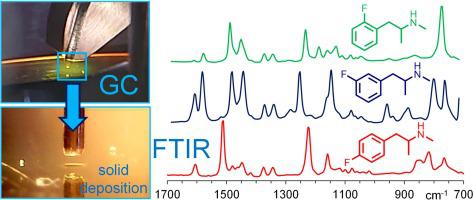Forensic Chemistry ( IF 2.6 ) Pub Date : 2021-07-21 , DOI: 10.1016/j.forc.2021.100346 Ruben F. Kranenburg 1, 2 , Laura I. Stuyver 1 , Renee de Ridder 1 , Annique van Beek 1 , Erik Colmsee 1 , Arian C. van Asten 2, 3

|
List-based approaches for judicial control of synthetic drugs inevitably introduce a group of legal highs that do not fall under the scope of legislation but may exhibit similar effects and associated health risks as illicit substances. Differences between controlled and uncontrolled components may be as minor as a single molecular group rearrangement. This phenomenon complicated forensic drug analysis in recent years due to both the rise of new psychoactive substances (NPS), and selectivity limitations of the workhorse gas chromatography-mass spectrometry (GC−MS) technique, especially with respect to ring-isomers. Our study demonstrates the value of GC-solid deposition-Fourier-transform infrared spectroscopy (FTIR) as a complementary technique for NPS identification in multi-drug mixtures. The instrument design using direct deposition of the GC effluent on a cryogenically cooled ZnSe-disk allows for signal enhancement of minor constituents by collecting eluting peaks of multiple GC injections. Highly diagnostic spectra were obtained for all ortho, meta and para-isomers of fluoroamphetamine (FA), fluoromethamphetamine (FMA), methylmethcathinone (MMC) and methylethcathinone (MEC). Combined results of GC−MS and GC-solid deposition-FTIR revealed the presence of up to 11 individual NPS mixed together in liquid samples sold as research chemicals or room odorizer in The Netherlands. Sample compositions rapidly evolved over time with recently controlled substances such as 4-fluoroamphetamine (4-FA), pentedrone, ethylone and 4-methylethcathinone (4-MEC) being replaced by uncontrolled isomers or analogues as 2-fluoroamphetamine (2-FA), 2- or 4-fluoromethamphetamine (2-FMA, 4-FMA) and dimethylone. In 12 different samples all marketed under two brand names, a total of 9 different compositions were identified in samples from 2018 and 2019.
中文翻译:

故意逃避麻醉品立法:通过 GC-固体沉积-FTIR 分析的新型精神活性物质的商业混合物中的趋势可视化
基于清单的合成药物司法控制方法不可避免地会引入一组不属于立法范围但可能表现出与非法物质类似的影响和相关健康风险的合法高点。受控和非受控组分之间的差异可能与单个分子基团重排一样小。由于新的精神活性物质 (NPS) 的兴起以及主力气相色谱-质谱 (GC-MS) 技术的选择性限制,尤其是在环异构体方面,这种现象近年来使法医药物分析变得复杂。我们的研究证明了 GC 固体沉积傅立叶变换红外光谱 (FTIR) 作为多药混合物中 NPS 识别的补充技术的价值。仪器设计使用 GC 流出物直接沉积在低温冷却的 ZnSe 盘上,通过收集多次 GC 进样的洗脱峰来增强微量成分的信号。获得了所有的高度诊断光谱氟苯丙胺 (FA)、氟甲基苯丙胺 (FMA)、甲基甲卡西酮 (MMC) 和甲基乙卡西酮 (MEC) 的邻位、间位和对位异构体。GC-MS 和 GC-固体沉积-FTIR 的综合结果显示,在作为研究化学品或室内加臭剂出售的液体样品中,存在多达 11 种单独的 NPS 混合在一起在荷兰。样品组成随着时间的推移迅速演变,最近受控物质如 4-氟苯丙胺 (4-FA)、戊四酮、乙酮和 4-甲基乙卡西酮 (4-MEC) 被不受控制的异构体或类似物取代,如 2-氟苯丙胺 (2-FA), 2- 或 4- 氟甲基苯丙胺(2-FMA、4-FMA)和二甲基甲酮。在所有以两个品牌销售的 12 个不同样品中,在 2018 年和 2019 年的样品中总共确定了 9 种不同的成分。











































 京公网安备 11010802027423号
京公网安备 11010802027423号